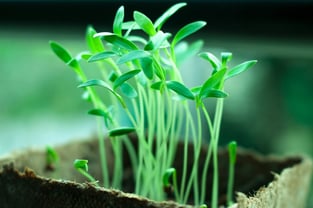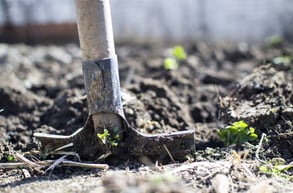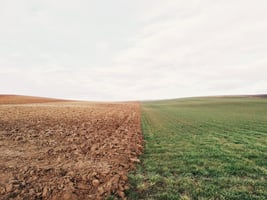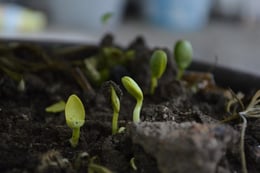What is Soil Compaction?
Good soil should be loose, with many pockets of air between its particles, so oxygen and water can circulate freely to deliver nutrients and facilitate chemical and biological activity. The balance of a good soil is delicate, and there are a number of reasons why a soil can get “crushed” and become denser, with significantly less air between the soil particles. This change of the soil texture is what experts call soil compaction. Wet soils are even more vulnerable to compaction than sandy ones since the water helps pack soil particles even closer together.
You may wonder if your soil is compacted. There are some easily detected symptoms that should give you pause and make you investigate more profoundly: for example, if your soil is very hard to dig, regardless of whether it is wet or dry. Also, take a good look after the rain: is water puddling and draining very slowly - or not at all?

The weeds affecting your crops may also give you an indication of whether the soil is compacted or not since their root systems allow them to thrive in compacted soils where other plants suffer. Some of these weeds are plantain, chicory, mustard, bindweed, and knotweed. If those are a big problem for you, they are not your only problem: you have soil compaction issues.
You may examine your soil for compaction by digging a small pit to examine the soil profile, using your eyes and a small knife to test and understand the layers that form the soil at various depths. You may also use a hand probe: a steel rod with a handle that you push into the soil, and which will allow you to feel how difficult the soil is to penetrate at various depths. And if you’re really fancy, you can rent a cone penetrometer to get exact numbers on the force required to penetrate the soil. Here are some numbers in case you’re curious: if penetrating the soil requires a force of 1.5 MPa or more, plant root growth will start to be restricted. If the force required reaches 2.5 MPa or more, plant growth will be severely affected since the roots will have serious restrictions on their growth.
One more thing: compaction has different effects (and solutions) depending on how deep it is. Compaction near the surface is easy to notice, short-lived, and easy to fix since fields are plowed periodically. However, compaction that occurs below plowing depth is a real issue - subsoil compaction happens at depths of 8-14 inches and is difficult to resolve. Prevention is key since experts agree soil compaction is one of the top 8 causes of soil degradation worldwide. Soil strength is desirable for builders, but if you want successful crops you need your soil to be well structured and loose.
What Causes Soil Compaction?
The main cause for soil compaction is putting weight on the soil, and this happens a lot in farmed lands, either as foot traffic, stock trampling or through the massive weight of agricultural machinery. You will hear this repeatedly throughout this guide: driving heavy equipment over wet soils is the #1 cause of severe soil compaction.
Machinery
Agricultural lands, especially if operating on a commercial scale, require the assistance of heavy machinery: tractors, plows, threshers and so many other wonderful inventions that allow massive increases in productivity and efficiency. However, these machines also have heavy axle loads, and they compact the soil under their wheel tracks more and more with every pass.

Consider this fact: studies have shown that 70% of soil compaction happens during the first pass of wheel traffic. That's quite an unforgiving statistic if you think about how some activities (like planting or harvesting)require rolling over an entire field.
Here’s another fact for you: under standard farm practices, as much as 90% of a field will be tracked every year, so it could already be suffering from up to 70% compaction effects due to wheel traffic. But there’s more: experts estimate that a good part of a field will be rolled over repeatedly, up to 4 or 5 wheel passes. Clearly, you will need some long term strategies to prevent the very machines which increase your crop yield from degrading your soil.
Heavy Traffic and Bad Practice
The increasing weight of agricultural machinery means a greater risk for compaction, but the way those machines are used can also aggravate the situation.
For example, a field which is repeatedly cultivated at the same depth develops what is called hardpan or plow pan compaction layer: a solidified layer of soil a couple of inches thick, which becomes compacted just under the base of the plow. If you dig a small trench to study hardpan compaction, you may find roots growing horizontally above the hardpan, since they are unable to penetrate the hardened layer of soil.
Another circumstance which increases compaction of the soil is using heavy machinery when the soil is wet. Soil moisture makes a big difference in the depth of compaction if all other factors are kept the same: the wetter the soil, the greater the compaction. Here’s an easy test you should do before rolling any heavy machinery over a wet field: grab a handful of soil, and try to make a ball with it. If you can make a ball, the soil is too wet for heavy traffic - wait for a couple of sunny days to dry it out and try again. Using heavy machinery on wet soil can create compaction problems that will take years to fix.

How Can Compacted Soil Affect You?
Soil compaction is among the top causes of soil degradation around the world - we consulted expert sources from Canada, the Netherlands, the USA, Australia and India to write this guide, and it is a real problem for farmers everywhere. Soil compaction hinders plant growth, decreases crop production and to make matters worse, the effects of compaction may take years to reverse.
Poor Root Growth
Since one of the main effects of compaction is to reduce soil porosity, there is less movement of air and water in the soil, leading to dehydrated and malnourished roots that may get swollen tips of not develop properly.
In especially severe cases, where the bulk density is really high, roots may grow sideways because they are unable to penetrate the hardpan to reach the lower layers of the soil.
Dehydrated Plants & Crops
Soil compaction disrupts the flow of water through the soil, decreasing both the soil’s capacity for absorbing water and its drainage capabilities regardless of soil type. Since water percolates much more slowly than it should, many of the microbes living in waterlogged soil have to start using nitrate instead of oxygen to perform their basic functions, basically robbing the soil of nitrates which are required by plants. And paradoxically, even though compacted soil tends to retain water, plants growing in compacted soil are much more vulnerable to drought because of their underdeveloped, small root systems.

Increased Energy Consumption by Tractors
If you think the solution to a plow pan is to plow deeper, you’re halfway there to understanding why soil compaction leads to higher energy consumption. The more you overwork your soil, the harder it will get, and therefore the more plowing and breaking it will need the next time. This creates a vicious cycle, in which tillage to relieve compaction just destroys the soil’s structure, which in turn makes it that much more susceptible to compaction.
How Can You Reduce Soil Compaction?
The best ways to reduce soil compaction take a long time since they rely on planting long-rooted crops to break down the soil, as well as on freeze-thaw cycles to re-create pores into the soil. Mixing sand into wet soils is a controversial measure, since adding too little will only aggravate the problem, and adding a large amount may become very costly.
In general, what you want to do is prevent compaction at all costs, and to do that you must be mindful of the following good practices:
Reduce Tire Pressure & Use Lighter Axle Loads
Control traffic of heavy machinery to prevent most of your compaction issues. We understand that some jobs are just too big and require heavy equipment, but there are several ways in which you can reduce the compaction and damage caused by the machinery you bring in to help.
Whenever possible, reduce axle loads, as deep compaction increases dramatically when axle loads are greater than 5 tons. One way to do this is to remove all excess weight on the machinery and to only use enough ballast to give the wheels a good grip. Do not overload wagons, do not run loaded trucks over your fields, and do the loading and unloading at the heads of the fields. Additionally, remove excess weight on machinery and use only enough ballast to reduce slippage.

Tire pressure can make a big difference on the pressure applied to the soil since it can significantly increase or decrease the area over which the weight of the equipment is distributed. If you’re using vehicles with tires, keep in mind that tire pressure is roughly the same as contact pressure. Reduce the air pressure as much as you can, and if it is still too high consider flotation tires or larger diameter tires. Tracked vehicles cause less damage than tires inflated at high pressure since the weight is better distributed, but tires with a low pressure cause less damage than tracks.
Reduce trafficked areas
There are several ways to decrease the area compacted by machinery traffic, such as increasing the swath width of spreaders and other such equipment. Having more space between the wheels, to keep individual wheel tracks further apart can also help prevent soil compaction. Experts advocate the use of permanent lanes, so heavy traffic runs always over the same lanes, and the area between those lanes is never subject to compaction. It has some logistical drawbacks but has proven to be a promising approach.
Stick to a Farm Operations Schedule

If you’re in the market for a tattoo, make it say “Don’t drive over wet soil!” It is that important. Compaction goes significantly deeper when a heavy machine rolls over wet soil, and the damage can take years to correct. Wait a day or two if the soil is wet enough to form a ball.
If this is an issue for you, and you think your soil is seldom dry enough to work on, then you need to start thinking about adding drainage systems to your fields. Once more: experts agree that heavy traffic over very wet soil causes a “hydraulic ram” effect, in which the compression is not limited to the topsoil, but also goes as far as the subsoil, creating subsoil compaction.
Reinforce your soil against compaction
There are several ways to help a soil fight compaction - ensuring it drains well is the first one. Check your soil type, and add sand or other aggregates as required to make sure your soil can drain effectively - this will prevent compaction and enhance soil structure.
The other main way to keep soil aerated and loose is to ensure there is plenty of organic matter in it. Organic matter helps maintain soil porosity, and it also supports and encourages all the life in the subsoil, from microbes to worms and other animals. All of these organisms are known as soil biota, and they are your best allies for keeping your soil and your plants healthy.
Where to Find Anticompaction Soil?
How we wish we could tell you where to find anticompaction soil! Alas, it has not been invented yet. For everything else, come to Minick materials: we have a wide array of soils, sand, aggregates, compost, and everything else you need to fight soil compaction and enhance your crop yield and productivity. No order is too small and no question is too basic - our expert customer service associates will be delighted to help you out, whether you’re planting a backyard veggie patch or several acres of corn.


![All About Soil Compaction: Causes, Challenges & Solutions [A Guide]](https://www.minickmaterials.com/hubfs/Imported_Blog_Media/plants-2411458_1920-1024x683.jpg)






![All About Soil Compaction: Causes, Challenges & Solutions [A Guide]](https://www.minickmaterials.com/hs-fs/hubfs/Imported_Blog_Media/plants-2411458_1920-1024x683.jpg?width=725&name=plants-2411458_1920-1024x683.jpg)
.webp?width=725&name=AdobeStock_462076409%20(1).webp)